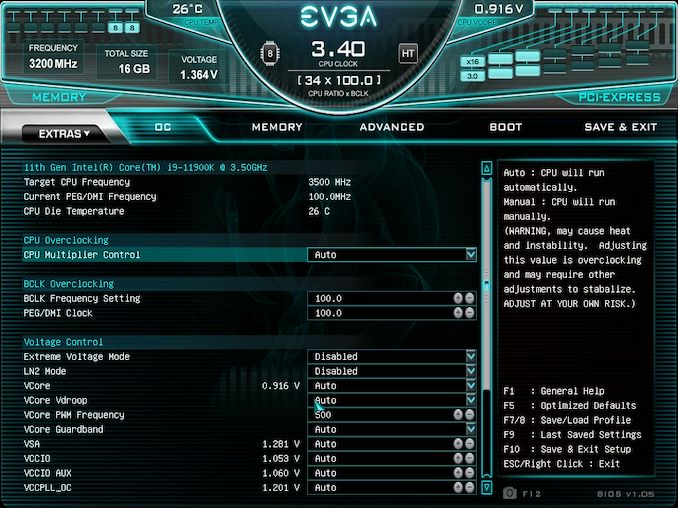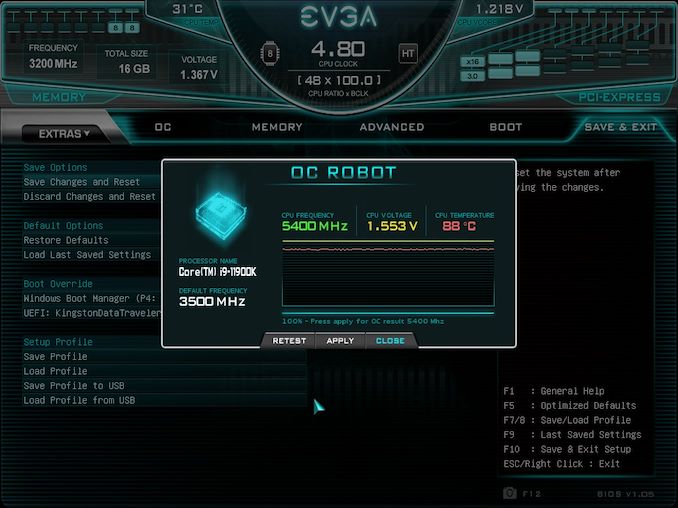The EVGA Z590 Dark Motherboard Review: For Extreme Enthusiasts
by Gavin Bonshor on October 15, 2021 9:00 AM ESTOverclocking
The skill of overclocking is one that can take thousands of hours to get to grip with the hardware, software, and then a new processor generation comes along which requires half of it to be learned again! Getting the right combination of settings to deliver an optimized yet stable enough system to deliver the performance can be time-consuming and tedious. Despite the excellent work from both Intel and AMD over the last couple of years with its interpretations of 'turbo' and 'boost,' this doesn't typically affect all of the cores equally, and instead focuses on one or two for that immediate single thread push. On an eight-core processor such as the Intel Core i9-11900K, providing whatever software of application is being used can utilize the cores and threads, typically more performance can be had from pushing all of the cores higher. At present, Intel employs some of the most aggressive methods of automatic overclocking with its Thermal Velocity Boost (TVB), and more recently with Rocket Lake, its new Adaptive Boost Technology (ABT) on its 11th Gen Core i9 K and KF processors.
Perhaps the biggest disadvantage when it comes to overclocking the processor has to deal with the extra thermal and power implications. As Intel pushes its silicon almost to its limit right out of the factory, adequate cooling is needed. Due to previous experiences when overclocking our i9-11900K in previous Z590 reviews, we've seen power consumption figures surpassing 350 W when overclocking, which is a phenomenal amount of wattage for an eight-core chip. Even at default settings, new processors from both Intel and AMD typically run warmer than previous generations. Hence, we recommend using premium cooling solutions such as AIO CPU coolers or even large tower coolers to help manage the extra heat generated. But even with that said, in a good amount of our 11th Gen CPU overclock testing, it hasn't been worth the effort. The EVGA Z590 Dark, however, is geared for overclocking so we should see typically better performance than 'standard' Z590 models.
Experience with the EVGA Z590 Dark
As the EVGA Z590 Dark is one of around five overclocking-focused motherboards on the market, a lot of the firmware is dedicated to overclocking both Intel's 11th generation processors and the attached memory. All of the board's overclocking settings can be found within the OC section. This can be accessed by selecting the Enter Setup option from the initial splash screen.
Looking at the settings available within the OC section, users can overclock both the processor and Intel's UHD integrated graphics. Users can simply overclock the processor by adjusting the CPU Multiplier on an all-core or per-core basis and changing the CPU VCore. Much of the bread and butter with the Z590 Dark is the option for extreme overclockers, which includes an LN2 mode that unlocks the CPU VCore beyond what's available in 'normal' mode, and should only be done by experienced users. There's plenty of voltage options available and users can adjust all of Intel's TVB and ABT settings for more aggressive or conservative power control.
EVGA also includes extensive memory overclocking options. This includes the ability to enable XMP 2.0 memory profiles on compatible kits, as well as customize frequency, change Intel's Geared memory mode from 1:1 to 1:20, as well as loads of latency configuration options. EVGA has included a range of memory overclocking profiles for users with high binned memory, with profiles available from both KINGPIN and Luumi, who are two of the most renowned extreme overclockers in the world.
Included as part of the firmware is the EVGA OC Robot, which is a handy tool for letting the boards overclock the processor for users. What makes this unique is that the EVGA OC Robot includes a built-in stress tester which tests each frequency and voltage variation from a lookup table. Once it has gone through the motions, it outputs an all-core CPU overclock including both what it thinks is a stable frequency and CPU VCore. Users can go to retest the settings or apply them by clicking the apply button.
Overclocking Methodology
Our overclocking methodology is as follows. We select the automatic overclock options and test for stability with POV-Ray and Prime95 to simulate high-end workloads. These stability tests aim to catch any immediate causes for memory or CPU errors.
For manual overclocks, based on the information gathered from the previous testing, start off at a nominal voltage and CPU multiplier, and the multiplier is increased until the stability tests are failed. The CPU voltage is increased gradually until the stability tests are passed. The process is repeated until the motherboard reduces the multiplier automatically (due to safety protocol) or the CPU temperature reaches a stupidly high level (105ºC+). Our testbed is not in a case, which should push overclocks higher with fresher (cooler) air.
Overclocking Results
Overclocking our Core i9-11900K provided some interesting results on the EVGA Z590 Dark motherboard. Included with the Z590 Dark are the EVGA Gamer Mode and EVGA's OC Robot which is an automatic overclocking utility. We tested both and found that the Gamer Mode provided no real benefit over the board's default settings, giving us little more than a higher power draw during POV-Ray. The EVGA OC Robot came up with an all-core CPU Frequency of 5.4 GHz with a whopping 1.541 V on the CPU VCore. These settings did run, but with massive thermal throttling, and it came close to pulling 500 W of power, which is an insane power draw for an 8-core processor.
Testing overclocks manually from 4.7 GHz and beyond, we managed to achieve an all-core stable overclock of 5.2 GHz at 1.42 V on the CPU VCore. This was a little disappointing as we have been able to achieve 5.3 GHz all-core on this processor on other overclocking-focused models we've tested, so we know it can do better. We did notice very large levels of VDroop in our testing at both 5.1 and 5.2 GHz. From 4.7 GHz to 5.0 GHz, VDroop was relatively tight, however.
Overall we would have expected to achieve at least 5.3 GHz all-cores on the EVGA Z590 Dark, but it seems the real bread and butter of this board's performance will likely be unleashed with more extreme cooling methods.













27 Comments
View All Comments
YB1064 - Friday, October 15, 2021 - link
If this board is built for LN2 overclocking, then a review without testing this capability is incomplete. Come on guys, you used to do this in the past. What gives?Ryan Smith - Friday, October 15, 2021 - link
Speaking pragmatically, when we do that kind of testing, we're at serious risk of burning out a $500 CPU. For a comprehensive overclocking-focused article that may make sense, but for single motherboard review that's not a very good use of our resources.To be sure, it would be fun to do - and ideally I'd like to make it happen. But there are some niche features/configurations that even we can't justify the cost of testing.
niva - Friday, October 15, 2021 - link
Do people actually run their systems with LN2 cooling? Or is it something that just exists to be used temporarily when doing extreme benchmarks?I've been building PCs since the 90s and never even bothered with liquid coolers, never mind LN2. Seems like a complete gimmick and as you stated, risky. Not just for the CPU resources, but potentially dangerous to the people setting up the system.
shabby - Friday, October 15, 2021 - link
If it's targeted for ln2 that means they can charge a pretty penny for it, that's all it means.Ryan Smith - Friday, October 15, 2021 - link
You're correct: no one is using LN2 on a day-to-day basis. It's mostly for short use periods for extreme overclocking.amnesia0287 - Friday, October 15, 2021 - link
The stuff they change to make it work with LN2 still benefit everyone else, just less. Cause basically what they do is swap in higher quality chips that are better hardened. They tighten up the tolerances (which is why it’s only got 2 ram slots, to make the traces shorter and more consistent).Same with the upgrade to the power delivery and pci traces.
Can a human tell the difference from any of these things? No way, but they will certainly help a cpu last longer and run more stable. It just doesn’t make sense to spend on any current pc hardware with all the changes about to pop off. Just pci5 and the addition of cxl are gonna be huge.
Oxford Guy - Saturday, October 16, 2021 - link
‘Extreme overclocking’ = extreme marketing techniquefrozen_water - Friday, October 15, 2021 - link
Meh, having owned the z490 dark kp edition I think these boards are way overrated. Does this one still have a silkscreen URL for a non-existent TiN guide? Does this still not support Intel’s cryo/TEC coolers? It’s literally the most expensive oc motherboard out there and it lacks features that other much cheaper ones have.Silver5urfer - Friday, October 15, 2021 - link
Unfortunately TiN is retired from EVGA. He moved to US I guess due to family. Now those nice amazing articles on Xdevs are nowhere since Z490 series. The only person now covering this extensively is Luumi. Check his content, he also makes Win7 installs just like TiN as well.I'm eying this board with 10900K or X570 DARK if the AMD board also drops USB then I'm skipping Ryzen.
amnesia0287 - Friday, October 15, 2021 - link
OC motherboards mostly all a waste of money for most people. But just looking at the vrms, power delivery, tight uniform ram traces and such. They are extremely focused on pure electrical stability/consistency/reliability. Though certainly not to the same degree, it is built similarly to military hardened pc gear in some ways.